When Intel debuted their 13th Gen Intel Core processors late last year, they were quick to call it the world’s fastest desktop processor. At CES 2023, Intel is back at it again this time with the complete lineup of their 13th Gen Intel Core laptop processors, and just like before they also have a mobile chip so powerful they’re calling it the world’s fastest mobile processor.
The chip in question here is the Intel Core i9-13980HX, a 24-core behemoth of a laptop processor that’s built on top of the same die used for its desktop counterparts. Part of their HX-series of 55W processors, the Core i9-13980HX features eight of its Performance cores (P-cores) running at 2.2GHz base clocks and 5.6GHz boost clocks, along with 16 of its Efficiency cores (E-cores) at 1.6GHz base and 4.0GHz boost. This means it has the highest clock speeds yet in the laptop scene, as well as the most cores ever on a consumer laptop chip.

It also features a total of 32 threads, 36MB of L3 cache and integrated graphics with 32 EU cores, along with support for up to 128GB of both DDR4 and DDR5 RAM, overclocking capabilities and Thunderbolt 4 support. All of this power gives it up to 11% improvements in single-thread workloads and up to 49% faster multitasking performance compared to its 12th Gen counterpart, as well as 12% improvements in gaming.There’s the Core i9-13950HX and Core i9-13900HX too, which are similar chips with lower clock speeds.


Below the Core i9 lineup meanwhile is the Core i7-13850HX, packing eight P-cores at 2.1GHz base and 5.3GHz boost clocks, 12 E-cores at 1.5GHz base and 3.8GHz boost clocks, 28 threads, and 30MB of L3 cache. The Core i7-13700HX meanwhile cuts the E-core and thread count to eight and 24 respectively, while also having slower boost clock speeds. Then there’s the Core i7-13650HX too, which has six P-cores and eight E-cores at slightly higher base speeds, lower boost clocks, 20 threads, 24MB of L3 cache and weaker integrated graphics.
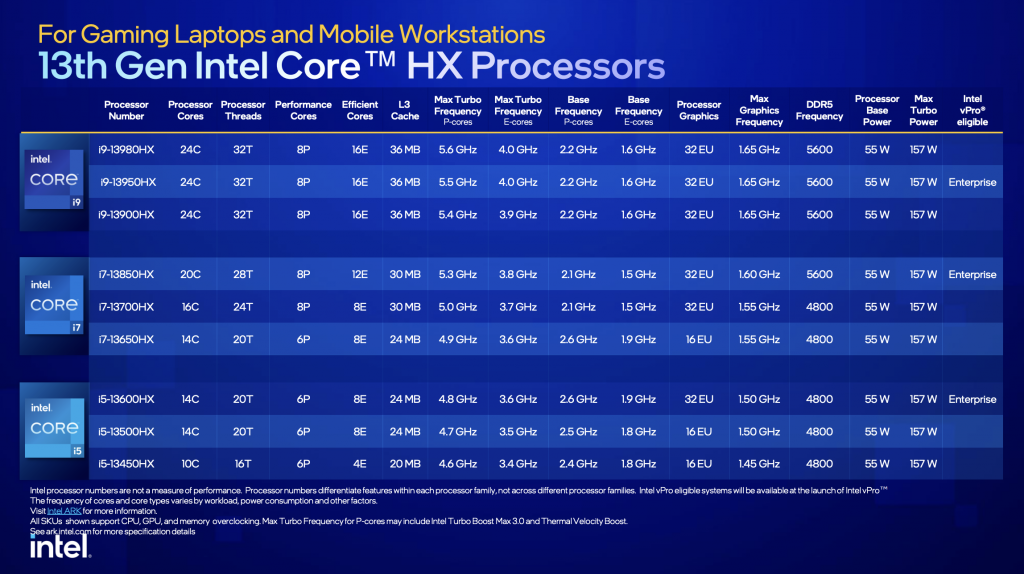
Finally, the HX-series gets rounded up with the Core i5-13600HX, which has six P-cores at 2.6GHz base and 4.8GHz boost clocks, eight E-cores at 1.9GHz base and 3.6GHz boost clocks, 20 threads, 24MB of L3 cache and integrated graphics with 32EU cores. The Core i5-13500HX is pretty similar to the former except with lower clock speeds across the board and weaker integrated graphics. The Core i5-13450HX meanwhile has just half the E-core count, four fewer threads and lower clock speeds.

Enthusiasts meanwhile who might not need the world’s most powerful mobile processor but would still need a beefy laptop can seek out one of the new 45W H-series mobile chips, which Intel claims offers around 10% of improved performance over last year’s silicon. The most powerful one here is the Intel Core i9-13900HK, an overclockable processor with six P-cores at 2.6GHz base and 5.4GHz boost clocks, eight E-cores at 1.9GHz base and 4.1GHz boost clocks, 20 threads, 24MB of L3 cache, and integrated graphics with 96EU cores. It’s supplemented with the Core i9-13900H and Core i9-13905H that have near similar specs, but are not overclockable.
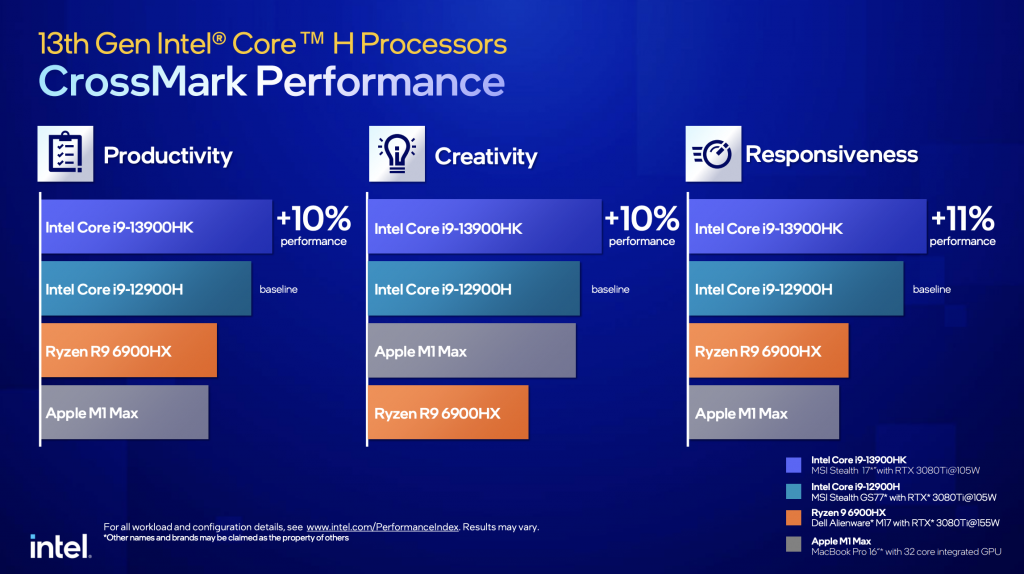
Below that we have the Core i7-13800H with six P-cores at 2.5GHz base and 5.2GHz boost, eight E-cores at 1.8GHz base and 4.0GHz boost clocks, 20 threads, 24MB of L3 cache and the same integrated graphics as before, complemented by the Core i7-13705H and Core i7-13700H which have lower clock speeds. Lastly, there’s the Core i5-13600H with four P-cores at 2.8GHz base and 4.8GHz boost, eight E-cores at 2.1GHz base and 3.6GHz boost clocks, 16 threads, 18MB of L3 cache and integrated graphics with 80EU cores. You’ll also find the Intel Core i5-13500H and Core i5-13505H with lower clock speeds below it.
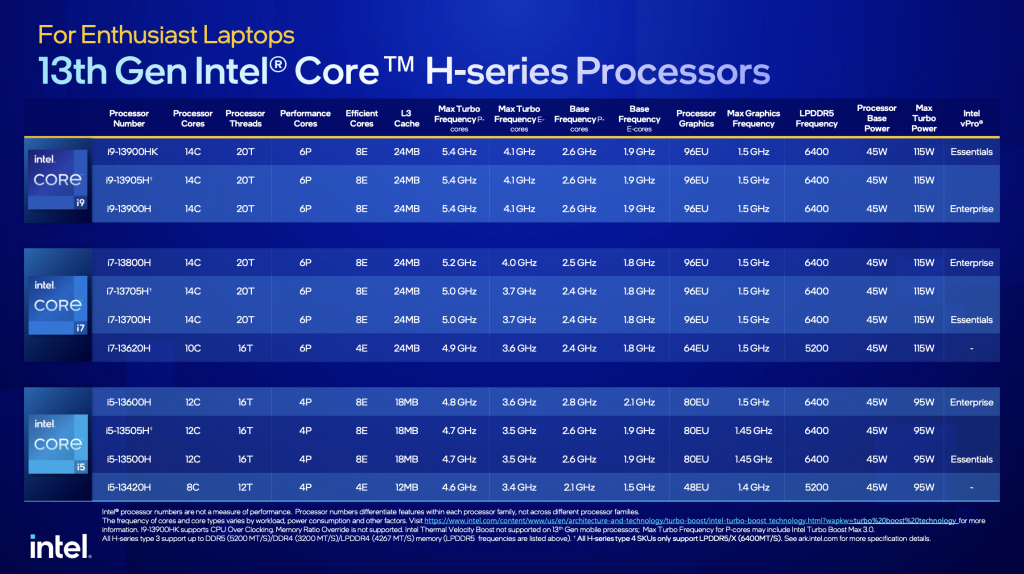
We also have new 28W P-series chips, which are meant for thin-and-light laptops that thread the fine line between raw performance and battery life. The Core i7-1370P is the most powerful one here, with six P-cores running at 1.9GHz base and 5.2GHz boost clocks, eight E-cores at 1.4GHz base and 3.9GHz boost, 24MB of L3 cache and integrated graphics with 96EU cores. Then there’s the Core i7-1360P with four P-cores running at 2.2GHz base and 5.0GHz boost clocks, eight E-cores at 1.6GHz base and 3.7GHz boost clocks, 16 threads, 18MB of L3 cache instead.
Sitting below them is the Intel Core i5-1340P with four P-cores at 1.9GHz base and 4.6GHz boost clocks, eight E-cores at 1.4GHz base and 3.4GHz boost clocks, 16 threads, 12MB of L3 cache and integrated graphics with 80 EU cores. The Core i5-1350P meanwhile is pretty similar barring some higher boost clocks.
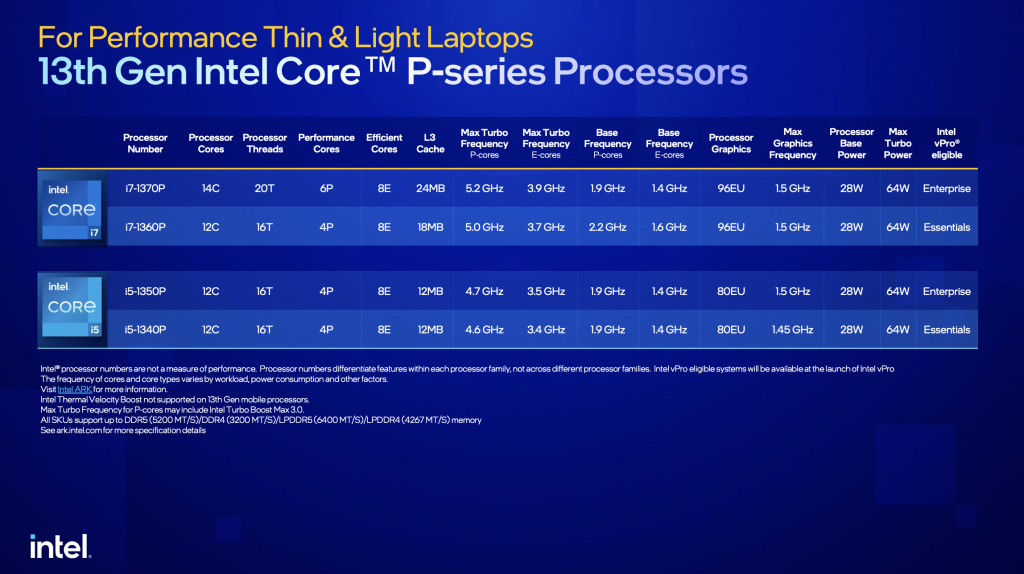
Lastly, we have the 15W U-series chips that are meant for thin-and-light laptops with a bigger focus on battery life and general usage rather than performance. There’s the Intel Core i7-1355U here with two P-cores at 1.7GHz base and 5.0GHz boost clocks, 8 E-cores at 1.2GHz base and 3.7GHz boost clocks along with a total of 12 threads, 12MB of L3 cache and integrated graphics with 96EU cores. You’ll also find its sibling the Core i7-1365U with slightly higher clock speeds across the board.
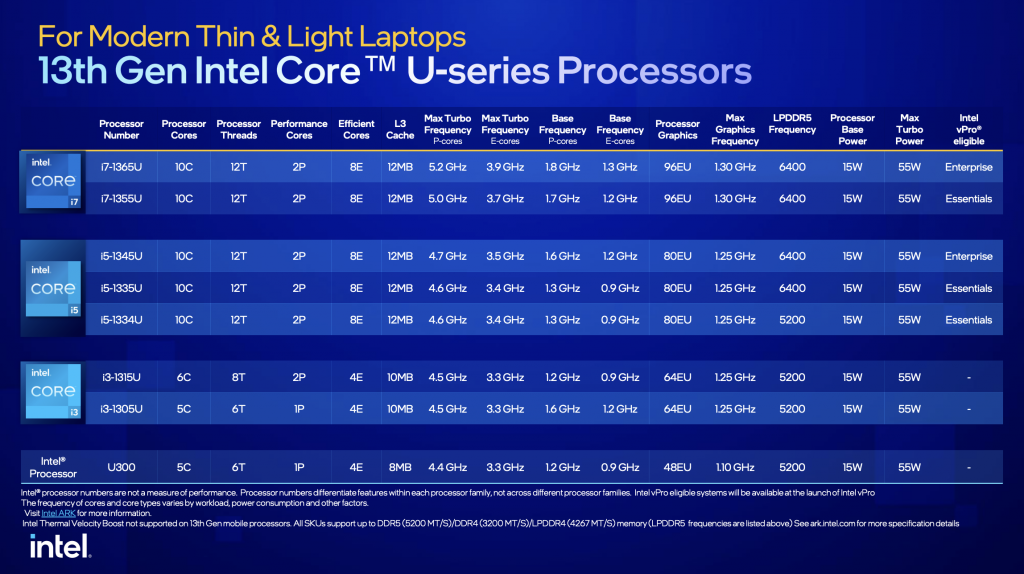
Below that is are the Intel Core i5-1335U and Core i5-1334U, two very similar chips with two P-cores at 1.3GHz base and 4.6GHz boost clocks, eight E-cores at 0.9GHz base and 3.4GHz boost clocks, 12 threads, 12MB of L3 cache and integrated graphics with 80EU cores. The key difference here though is that the Core i5-1334U is limited to 5200MHz LPDDR5 RAM, while the Core i5-1335U is able to support faster 6400MHz LPDDR5 RAM.
There’s a Core i5-1345U too, which is similar to the Core i5-1335U except with higher clock speeds. Rounding it all off meanwhile are the six core (2P+4E) and five core (1P+4E) Core i3-1315U and Core i3-1305U. You can expect to see all the processors mentioned above in over 300 different laptop designs appear throughout 2023.








